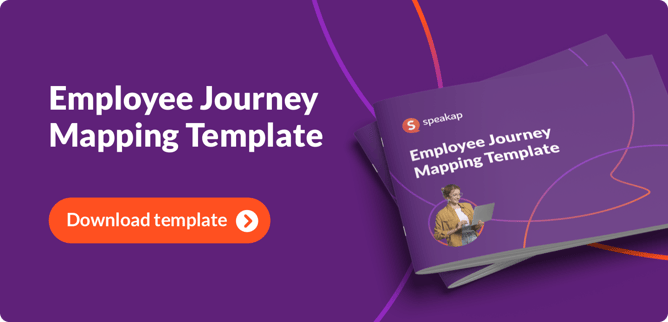Employee Journey Mapping: What is it & How to Get Started
Ready to learn how employee journey mapping can boost employee experience and benefit your business? In this blog, let’s explore employee journey mapping and why it’s essential. We’ll also touch upon its main components and share how you can create an employee journey map specific to your organization, benefiting both the employee and the business.
Quick idea: Implement an employee experience platform throughout the process. You'll see why later on.
Motivated, productive employees form the heart of successful organizations. And, it’s not just us saying, there’s much research that confirms this. For instance, a Harvard Business Review study shows that organizations can increase their revenue by 50% by moving from the bottom to the top quartile in employee experience metrics. Recognizing benefits like these, companies worldwide have started focusing on optimizing their employee experiences.
This is where the role of employee journey mapping comes in. Turns out, it’s precisely what you need to streamline the employee journey, add a personal touch, and strike the right note with employees.

What is employee journey mapping?
Employee journey mapping is the process of visualizing and analyzing the different stages, interactions, and experiences that make up an employee's journey during their entire tenure. This is helpful for HR leaders like you to implement processes and protocols using pre-decided tools and techniques to enhance employee experiences.
What are the components of employee journey mapping?
Employee journey mapping consists of several components that capture the different aspects of the employee experience journey map. While specific components may vary depending on your organizational objectives, common elements of most employee journey maps include:
Employee persona
Employee personas often differ across organizations. While some parts of employee experience can be common to all employees, there are other specialized aspects. These could depend on the job function and seniority levels. The employee journey map accounts for these differences. For example, a map specialized for entry-level data analysts or new-hire mid-level marketing managers.
Stages of the journey
Employee journeys start from the pre-hire phase and continue through post-employment. Typical stages include attraction/recruitment, onboarding, daily work life and engagement, career growth, and potentially off-boarding or exit. Employee journey maps reflect these stages so that you can build customized protocols for each stage and persona.
Touchpoints
This includes employee interactions with your company at various stages. For example, while submitting a job application, attending an interview, and receiving training.
Emotions
This includes the different emotional highs and lows employees experience at each stage. For example, excitement during recruitment, frustration during onboarding, or satisfaction upon achieving a milestone that the map accounts for.
Expectations
Understanding employees’ needs, motivations, and expectations is integral to effective journey maps. This component identifies what employees value in their workplace experience. For example, growth opportunities, supportive leadership, work-life balance, or a sense of belonging.

Why is employee journey mapping important?
Improvement in employee retention
When you implement employee journey mapping correctly, you get the ammunition necessary to tackle undesired feelings. For example, disengagement, resentment, and being unrecognized at each stage. These factors usually lead to resignations, a phenomenon on the rise. Statistically, turnover is expected to be 75% higher than pre-pandemic levels, with companies taking 18% longer to fill vacancies. Improved employee retention eliminates the cost and efforts associated with fresh recruitment.
Increase in employee engagement
Employee engagement is a core component of employee journey mapping. Journey maps provide the support you need to ensure high engagement levels at each stage. With them, you are also better equipped to address any communication gaps.
Streamlined onboarding
Journey mapping efforts address various pain points and opportunities employees commonly face during onboarding. This helps you ensure that new hires are transitioning smoothly from onboarding to training and professional development. Thus, you can ensure they operate at optimum productivity from day one with employee onboarding apps.
Strengthened employer brand
EX mapping includes efforts to maintain corporate brand consistency at each stage of the employee cycle. It identifies situations in each stage where you can consistently apply brand narratives. Examples include using stationery, logos, content tone and approach, etc. By doing this, you can transform your employees into brand representatives.
Enhanced employee morale
Employee experience journey mapping helps you implement practical activities and company gestures that can boost employee morale. Positive appraisals, employee recognition efforts, team-building activities, etc., are good examples.
The employee journey from the employer's perspective
As employers, employee journey mapping is the most straightforward way for you to get a bird’s-eye view of your organization’s functions. Understanding the employee's perspective is crucial for identifying existing sentiments and emotions to enhance the employee experience. We mean this concerning the different stages and touch points within the employee journey. With it, you can better identify the existing sentiments and emotions to enhance the employee experience.
You can also address any friction points more quickly and easily. Thus, you must go for it, as it will help you boost motivation, productivity, and bottom-line figures!

How to create your employee journey map in 6 steps
The employee journey mapping process is complex and continuous. Here are a few points you need to remember when you're building your map:
Step 1: Understand your goals
Each employee lifecycle stage has different goals and outcomes. Identify these as they can give you a clear direction to the components of your employee journey map. Segment each stage into smaller chunks to locate and create pathways to achieve these goals. You can use tools like ClickUp and Monday.com to brainstorm and track goals during each stage.
Step 2: Identify your workforce segments
Segment your diverse workforce into meaningful groups based on demographics, job roles, and seniority. This will help you address them in a tailored manner. You can use tools like PowerBI and Tableau to analyze vast HR data easily.
Step 3: Create multiple employee journey maps for each persona
Follow a segmented approach. Run multiple focused campaigns for the different employee personas across various stages. Tools like Custellence and UXPressia can help you design comprehensive maps for each identified persona.
Step 4: Analyze and identify opportunities
Once you collect data, make sure you analyze it deeply and gather insights to assess the status of employee experiences. With that, you can identify opportunities to improve.
Step 5: Revisit your employee journey map often
As EX is a dynamic concept, make sure you visit your employee journey maps at regular intervals. When you do that, make necessary changes to adjust wherever required.
Step 6: Conduct regular surveys and gather information to understand employees:
There's no substitute for primary data when it comes to knowing the reality, and surveys are the best way to obtain it. Make sure you conduct them regularly to align your employee journey map with evolving pain points and organizational goals. Handy survey tools include SurveyMonkey, Google Forms, and Typeform.
Inspired?
Here's an employee journey mapping template to get started
Below, we've listed a suggestive employee journey map template. Feel free to customize it for your unique business needs.
Stage 1: Attraction
Touchpoints: Job postings, company career page, employee referrals, and social media presence.
Predominant emotions: Excitement, curiosity, and frustration.
Strategies:
- Enhance job descriptions
- Optimize the career page for mobile devices
- Implement an employee referral program.
Stage 2: Recruitment
Touchpoints: Initial contact with recruiters and the interview process
Predominant emotions: Nervousness, confidence, and disappointment.
Strategies:
- Provide timely feedback to candidates
- Personalize communication
- Streamline the offer negotiation process.
Stage 3: Onboarding
Touchpoints: Welcome message from HR, orientation sessions, access to necessary tools and resources during the onboarding process.
Predominant emotions: Eagerness, feeling overwhelmed, gratitude
Strategies:
- Create a comprehensive onboarding checklist
- Implement a buddy system
- Collect feedback from new hires.
Stage 4: Development
Touchpoints: Performance reviews and training and development.
Predominant emotions: Engagement, frustration, disillusionment, and satisfaction.
Strategies:
- Provide regular feedback and coaching
- Offer personalized learning paths
- Create clear pathways for internal career advancement.
Stage 5: Engagement
Touchpoints: Team meetings, recognition and rewards programs, and employee feedback mechanisms.
Predominant emotions: Ambition, feeling validated when recognized, disappointments, and resentment.
Strategies:
- Foster an open communication culture
- Recognize and celebrate achievements and milestones.
- Implement team-building activities
Stage 6: Retention
Touchpoints: Performance incentives, work-life balance initiatives, and opportunities for career development.
Predominant emotions: Thoughtfulness, feelings of goodwill and altruism, resentment, escapism.
Strategies:
- Offer flexible work arrangement
- Ensure competitive compensation to retain top talent
- Invest in employee wellness programs.
Stage 7: Exit
Touchpoints: Exit interviews, offboarding process, and alumni network.
Predominant emotions: Reflectiveness, relief, disconnectedness, disappointment (contradictory emotions can co-exist).
Strategies:
- Use exit interviews to gather constructive criticism
- Make sure the exit is graceful and not hurried and cold
- Enroll ex-employees in an alumni network
Best Practices for Employee Journey Mapping
Employee journey mapping is a powerful tool for organizations to understand and improve the employee experience. To get the most out of this process, it’s essential to follow best practices. Here are some guidelines to help you create an effective employee journey map:
Involve multiple stakeholders
Employee journey mapping is a cross-functional process that requires input from various departments, including HR, IT, internal communications, and management. By involving multiple stakeholders, you ensure that the journey map reflects a comprehensive view of the employee experience from different perspectives.
Use employee feedback
Collect feedback from employees at different stages of their journey to gain a deeper understanding of their needs, pain points, and expectations. This feedback is invaluable in identifying areas for improvement and ensuring that the journey map is grounded in real experiences.
Focus on key moments
Identify critical moments in the employee journey, such as onboarding, performance reviews, and career development, and prioritize these areas for improvement. By focusing on these key moments, you can make targeted changes that have a significant impact on the overall employee experience.
Use visual representations
Create visual representations of the employee journey, such as journey maps or personas, to help stakeholders understand the employee experience. Visual tools make it easier to communicate complex information and ensure that everyone is on the same page.
Continuously iterate and refine
Employee journey mapping is an ongoing process. Continuously collect feedback, iterate, and refine the journey map to ensure it remains relevant and effective. Regular updates help you stay aligned with evolving employee needs and organizational goals.

Measuring the Success of Employee Journey Mapping
Measuring the success of employee journey mapping is crucial to understanding its impact on the organization. Here are some metrics to help you evaluate the effectiveness of your employee journey mapping efforts:
Employee engagement
Measure employee engagement through surveys, focus groups, or other feedback mechanisms to understand how employees feel about their experience. High engagement levels indicate a positive employee journey.
Turnover rates
Track turnover rates to see if employee journey mapping has reduced employee turnover. A decrease in turnover rates suggests that employees are more satisfied and committed to the organization.
Employee satisfaction
Measure employee satisfaction through surveys or feedback mechanisms to understand how employees feel about their experience. High satisfaction levels are a strong indicator of a successful employee journey.
Net Promoter Score (NPS)
Measure the NPS of employees to understand their willingness to recommend the organization as a place to work. A high NPS indicates that employees are likely to speak positively about their experience.
Return on Investment (ROI)
Calculate the ROI of employee journey mapping efforts to understand the financial impact on the organization. A positive ROI demonstrates that the investment in improving the employee journey is yielding tangible benefits.

Bottom line: Leverage employee journey mapping to boost employee experiences
Employee journey mapping provides the context and blueprint you need for taking focused actions concerning different employee lifecycle stages. If you implement and follow the framework in your organization, you can improve employees' experiences. This will unfold several benefits, from enhancing retention to increasing engagement and boosting productivity.
A simple way to build robust employee journey maps and streamline employee experiences across different stages is to use a branded and user-friendly employee experience app. This will help you connect across your workforce, improve communication, simplify task management, and analyze your data from a unified interface.
Want to boost productivity, coordination, and engagement in your organization?
Employee Journey Mapping: What is it & How to Get Started

Ready to learn how employee journey mapping can boost employee experience and benefit your business? In this blog, let’s explore employee journey mapping and why it’s essential. We’ll also touch upon its main components and share how you can create an employee journey map specific to your organization, benefiting both the employee and the business.
Quick idea: Implement an employee experience platform throughout the process. You'll see why later on.
Motivated, productive employees form the heart of successful organizations. And, it’s not just us saying, there’s much research that confirms this. For instance, a Harvard Business Review study shows that organizations can increase their revenue by 50% by moving from the bottom to the top quartile in employee experience metrics. Recognizing benefits like these, companies worldwide have started focusing on optimizing their employee experiences.
This is where the role of employee journey mapping comes in. Turns out, it’s precisely what you need to streamline the employee journey, add a personal touch, and strike the right note with employees.

What is employee journey mapping?
Employee journey mapping is the process of visualizing and analyzing the different stages, interactions, and experiences that make up an employee's journey during their entire tenure. This is helpful for HR leaders like you to implement processes and protocols using pre-decided tools and techniques to enhance employee experiences.
What are the components of employee journey mapping?
Employee journey mapping consists of several components that capture the different aspects of the employee experience journey map. While specific components may vary depending on your organizational objectives, common elements of most employee journey maps include:
Employee persona
Employee personas often differ across organizations. While some parts of employee experience can be common to all employees, there are other specialized aspects. These could depend on the job function and seniority levels. The employee journey map accounts for these differences. For example, a map specialized for entry-level data analysts or new-hire mid-level marketing managers.
Stages of the journey
Employee journeys start from the pre-hire phase and continue through post-employment. Typical stages include attraction/recruitment, onboarding, daily work life and engagement, career growth, and potentially off-boarding or exit. Employee journey maps reflect these stages so that you can build customized protocols for each stage and persona.
Touchpoints
This includes employee interactions with your company at various stages. For example, while submitting a job application, attending an interview, and receiving training.
Emotions
This includes the different emotional highs and lows employees experience at each stage. For example, excitement during recruitment, frustration during onboarding, or satisfaction upon achieving a milestone that the map accounts for.
Expectations
Understanding employees’ needs, motivations, and expectations is integral to effective journey maps. This component identifies what employees value in their workplace experience. For example, growth opportunities, supportive leadership, work-life balance, or a sense of belonging.

Why is employee journey mapping important?
Improvement in employee retention
When you implement employee journey mapping correctly, you get the ammunition necessary to tackle undesired feelings. For example, disengagement, resentment, and being unrecognized at each stage. These factors usually lead to resignations, a phenomenon on the rise. Statistically, turnover is expected to be 75% higher than pre-pandemic levels, with companies taking 18% longer to fill vacancies. Improved employee retention eliminates the cost and efforts associated with fresh recruitment.
Increase in employee engagement
Employee engagement is a core component of employee journey mapping. Journey maps provide the support you need to ensure high engagement levels at each stage. With them, you are also better equipped to address any communication gaps.
Streamlined onboarding
Journey mapping efforts address various pain points and opportunities employees commonly face during onboarding. This helps you ensure that new hires are transitioning smoothly from onboarding to training and professional development. Thus, you can ensure they operate at optimum productivity from day one with employee onboarding apps.
Strengthened employer brand
EX mapping includes efforts to maintain corporate brand consistency at each stage of the employee cycle. It identifies situations in each stage where you can consistently apply brand narratives. Examples include using stationery, logos, content tone and approach, etc. By doing this, you can transform your employees into brand representatives.
Enhanced employee morale
Employee experience journey mapping helps you implement practical activities and company gestures that can boost employee morale. Positive appraisals, employee recognition efforts, team-building activities, etc., are good examples.
The employee journey from the employer's perspective
As employers, employee journey mapping is the most straightforward way for you to get a bird’s-eye view of your organization’s functions. Understanding the employee's perspective is crucial for identifying existing sentiments and emotions to enhance the employee experience. We mean this concerning the different stages and touch points within the employee journey. With it, you can better identify the existing sentiments and emotions to enhance the employee experience.
You can also address any friction points more quickly and easily. Thus, you must go for it, as it will help you boost motivation, productivity, and bottom-line figures!

How to create your employee journey map in 6 steps
The employee journey mapping process is complex and continuous. Here are a few points you need to remember when you're building your map:
Step 1: Understand your goals
Each employee lifecycle stage has different goals and outcomes. Identify these as they can give you a clear direction to the components of your employee journey map. Segment each stage into smaller chunks to locate and create pathways to achieve these goals. You can use tools like ClickUp and Monday.com to brainstorm and track goals during each stage.
Step 2: Identify your workforce segments
Segment your diverse workforce into meaningful groups based on demographics, job roles, and seniority. This will help you address them in a tailored manner. You can use tools like PowerBI and Tableau to analyze vast HR data easily.
Step 3: Create multiple employee journey maps for each persona
Follow a segmented approach. Run multiple focused campaigns for the different employee personas across various stages. Tools like Custellence and UXPressia can help you design comprehensive maps for each identified persona.
Step 4: Analyze and identify opportunities
Once you collect data, make sure you analyze it deeply and gather insights to assess the status of employee experiences. With that, you can identify opportunities to improve.
Step 5: Revisit your employee journey map often
As EX is a dynamic concept, make sure you visit your employee journey maps at regular intervals. When you do that, make necessary changes to adjust wherever required.
Step 6: Conduct regular surveys and gather information to understand employees:
There's no substitute for primary data when it comes to knowing the reality, and surveys are the best way to obtain it. Make sure you conduct them regularly to align your employee journey map with evolving pain points and organizational goals. Handy survey tools include SurveyMonkey, Google Forms, and Typeform.
Inspired?
Here's an employee journey mapping template to get started
Below, we've listed a suggestive employee journey map template. Feel free to customize it for your unique business needs.
Stage 1: Attraction
Touchpoints: Job postings, company career page, employee referrals, and social media presence.
Predominant emotions: Excitement, curiosity, and frustration.
Strategies:
- Enhance job descriptions
- Optimize the career page for mobile devices
- Implement an employee referral program.
Stage 2: Recruitment
Touchpoints: Initial contact with recruiters and the interview process
Predominant emotions: Nervousness, confidence, and disappointment.
Strategies:
- Provide timely feedback to candidates
- Personalize communication
- Streamline the offer negotiation process.
Stage 3: Onboarding
Touchpoints: Welcome message from HR, orientation sessions, access to necessary tools and resources during the onboarding process.
Predominant emotions: Eagerness, feeling overwhelmed, gratitude
Strategies:
- Create a comprehensive onboarding checklist
- Implement a buddy system
- Collect feedback from new hires.
Stage 4: Development
Touchpoints: Performance reviews and training and development.
Predominant emotions: Engagement, frustration, disillusionment, and satisfaction.
Strategies:
- Provide regular feedback and coaching
- Offer personalized learning paths
- Create clear pathways for internal career advancement.
Stage 5: Engagement
Touchpoints: Team meetings, recognition and rewards programs, and employee feedback mechanisms.
Predominant emotions: Ambition, feeling validated when recognized, disappointments, and resentment.
Strategies:
- Foster an open communication culture
- Recognize and celebrate achievements and milestones.
- Implement team-building activities
Stage 6: Retention
Touchpoints: Performance incentives, work-life balance initiatives, and opportunities for career development.
Predominant emotions: Thoughtfulness, feelings of goodwill and altruism, resentment, escapism.
Strategies:
- Offer flexible work arrangement
- Ensure competitive compensation to retain top talent
- Invest in employee wellness programs.
Stage 7: Exit
Touchpoints: Exit interviews, offboarding process, and alumni network.
Predominant emotions: Reflectiveness, relief, disconnectedness, disappointment (contradictory emotions can co-exist).
Strategies:
- Use exit interviews to gather constructive criticism
- Make sure the exit is graceful and not hurried and cold
- Enroll ex-employees in an alumni network
Best Practices for Employee Journey Mapping
Employee journey mapping is a powerful tool for organizations to understand and improve the employee experience. To get the most out of this process, it’s essential to follow best practices. Here are some guidelines to help you create an effective employee journey map:
Involve multiple stakeholders
Employee journey mapping is a cross-functional process that requires input from various departments, including HR, IT, internal communications, and management. By involving multiple stakeholders, you ensure that the journey map reflects a comprehensive view of the employee experience from different perspectives.
Use employee feedback
Collect feedback from employees at different stages of their journey to gain a deeper understanding of their needs, pain points, and expectations. This feedback is invaluable in identifying areas for improvement and ensuring that the journey map is grounded in real experiences.
Focus on key moments
Identify critical moments in the employee journey, such as onboarding, performance reviews, and career development, and prioritize these areas for improvement. By focusing on these key moments, you can make targeted changes that have a significant impact on the overall employee experience.
Use visual representations
Create visual representations of the employee journey, such as journey maps or personas, to help stakeholders understand the employee experience. Visual tools make it easier to communicate complex information and ensure that everyone is on the same page.
Continuously iterate and refine
Employee journey mapping is an ongoing process. Continuously collect feedback, iterate, and refine the journey map to ensure it remains relevant and effective. Regular updates help you stay aligned with evolving employee needs and organizational goals.

Measuring the Success of Employee Journey Mapping
Measuring the success of employee journey mapping is crucial to understanding its impact on the organization. Here are some metrics to help you evaluate the effectiveness of your employee journey mapping efforts:
Employee engagement
Measure employee engagement through surveys, focus groups, or other feedback mechanisms to understand how employees feel about their experience. High engagement levels indicate a positive employee journey.
Turnover rates
Track turnover rates to see if employee journey mapping has reduced employee turnover. A decrease in turnover rates suggests that employees are more satisfied and committed to the organization.
Employee satisfaction
Measure employee satisfaction through surveys or feedback mechanisms to understand how employees feel about their experience. High satisfaction levels are a strong indicator of a successful employee journey.
Net Promoter Score (NPS)
Measure the NPS of employees to understand their willingness to recommend the organization as a place to work. A high NPS indicates that employees are likely to speak positively about their experience.
Return on Investment (ROI)
Calculate the ROI of employee journey mapping efforts to understand the financial impact on the organization. A positive ROI demonstrates that the investment in improving the employee journey is yielding tangible benefits.

Bottom line: Leverage employee journey mapping to boost employee experiences
Employee journey mapping provides the context and blueprint you need for taking focused actions concerning different employee lifecycle stages. If you implement and follow the framework in your organization, you can improve employees' experiences. This will unfold several benefits, from enhancing retention to increasing engagement and boosting productivity.
A simple way to build robust employee journey maps and streamline employee experiences across different stages is to use a branded and user-friendly employee experience app. This will help you connect across your workforce, improve communication, simplify task management, and analyze your data from a unified interface.
Want to boost productivity, coordination, and engagement in your organization?
Stay updated with the latest insights and trends delivered straight to your inbox.











